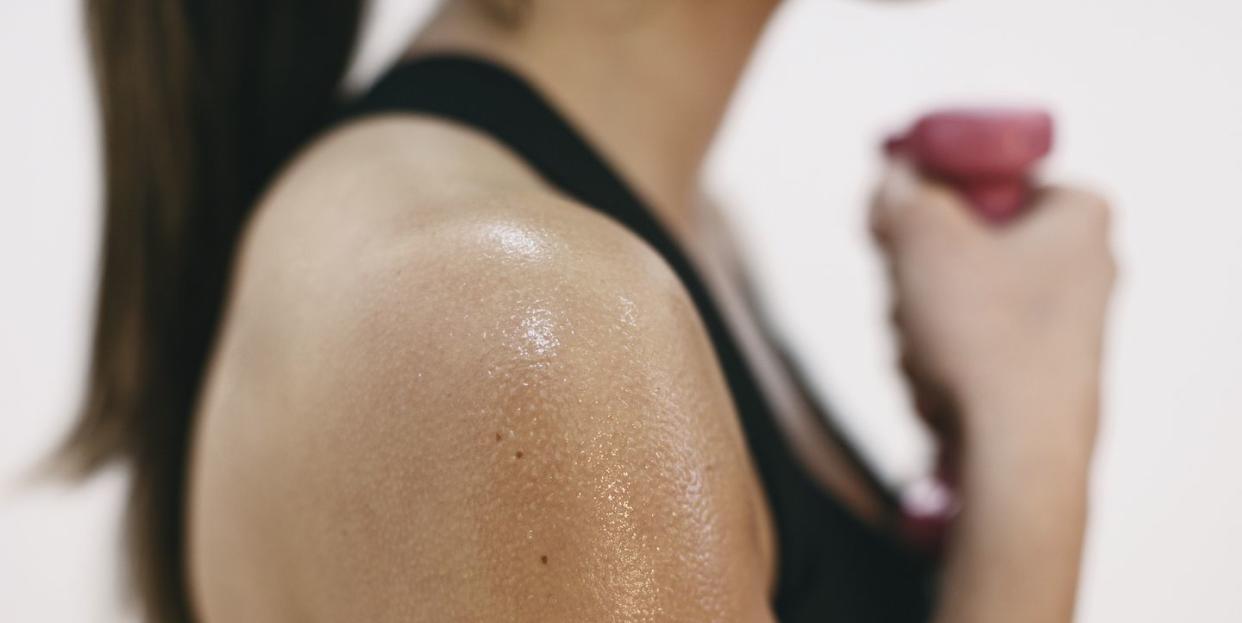What Is Fungal Acne, Really?

Between blackheads, whiteheads, cystic acne, and hormonal acne, it seems like there’s a never-ending list of types of breakouts that can follow you well into adulthood. One you’re probably less familiar with is fungal acne, which is equally as un-fun.
Here, a dermatologist breaks down what distinguishes fungal acne from traditional acne—and how you can best beat it.
What causes fungal acne and how is it different from regular breakouts?
Fungal acne is a type of infection that forms in the hair follicles and is caused by the overgrowth of a yeast called Malassezia furfur, says Adele D. Haimovic, MD, a board-certified dermatologist and clinical associate professor of dermatology at New York University Langone Medical Center. It usually crops up on the back, chest, or arms, she says. While it can also show up on your face, it’s not as common.
While Malassezia furfur is a yeast that naturally occurs on our skin, an overgrowth can lead to fungal acne. This yeast overgrowth can be due to various factors, including trapped moisture from staying in sweaty workout clothes too long, medications such as antibiotics, or living in warm and humid environments where you sweat more.
Fungal acne is commonly mistaken for facial acne, according to Dr. Haimovic, as it produces uniform and small pimples. However, a telltale sign that it's fungal acne (and not traditional acne)? You may be itchy. “There are no blackheads or deep painful cysts distinguishing fungal acne from classic facial acne, though many find the bumps itchy,” she explains.
If you're ever unsure, consult your dermatologist; they're trained to spot these things. It's also important to know what type of breakout you're dealing with because the treatments are so different.
How To Treat Fungal Acne
Since fungal acne is caused by an overgrowth of yeast, the good news is that it responds well to antifungal treatments, which can be purchased over the counter or with a prescription, Dr. Haimovic says. Look for ingredients like ketoconazole, econazole nitrate, or clotrimazole. You’ll often find these in the foot care aisle, as they’re often recommended to treat athlete’s foot.
“Often topical antifungal creams will be effective, however oral antifungals may be required for more persistent [breakouts],” she says. So, if the topical options are not working for you, see your dermatologist for a prescription.
Dandruff shampoos containing pyrithione zinc (like Head and Shoulders) or selenium sulfide (like Selsun) can also be helpful for fighting off fungal acne. You can use these like a cleanser on affected body parts as you're showering up.
Because fungal acne is easily mistaken for bacterial acne, you might be inclined to bust out your usual drugstore cleansers and creams. However, if you know you’re dealing with fungal acne, experts warn against doing this, as these products can be too harsh and may make the infection worse. They’re also not likely to work to treat fungal acne, since it’s caused by yeast overgrowth, Dr. Haimovic says.
How To Prevent Fungal Acne
Some of the common causes of fungal acne are easy to avoid, such as not sitting in sweaty workout clothes for too long, opting for loose-fitting clothes and showering regularly if you’re an excessive sweater, Dr. Haimovic says.
“Oral antibiotics can also change our skin flora and allow yeast to grow so avoiding antibiotics when possible is helpful,” she adds. (This means not taking antibiotics for things like viral illnesses (aka a cold or the flu) where they won't be effective anyway. If your doctor has recommended them to treat an infection that is known to respond to antibiotics, then you have the green light.)
All in all, fungal acne can masquerade as regular acne, but the treatments are vastly different. Rather than using your traditional OTC anti-acne creams, you'll likely need a topical or oral antifungal to treat fungal acne.
If you're unsure of where your bumps are coming from or if this is your first flare-up of fungal acne, visit your derm to make sure you’re dealing with the right diagnosis and to get an appropriate treatment plan.
You Might Also Like

